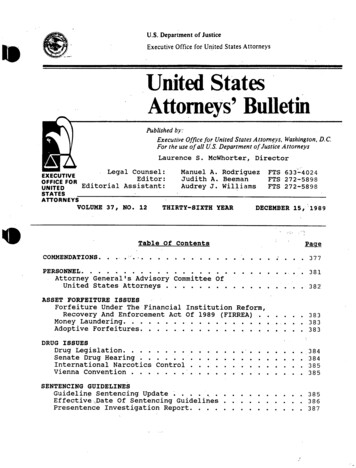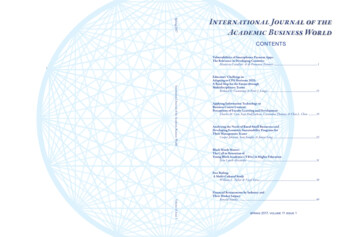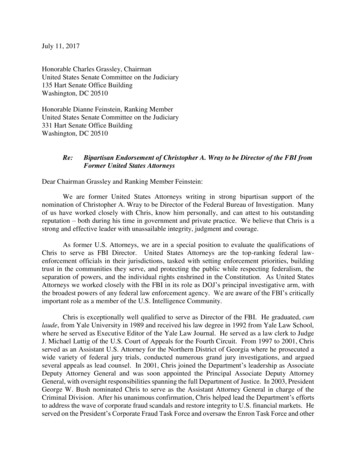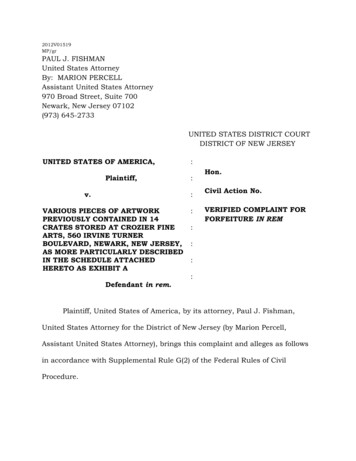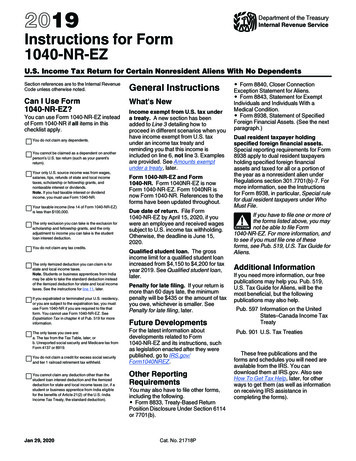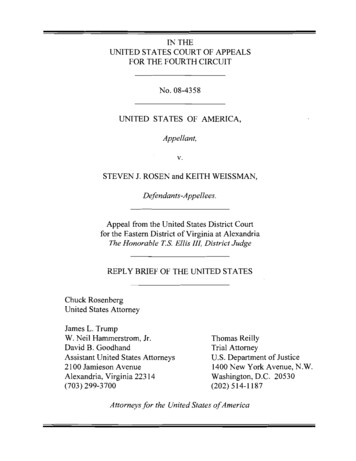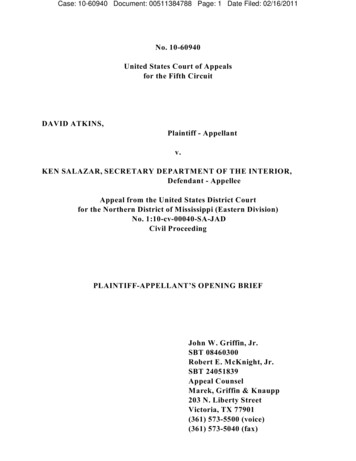
Transcription
Case: 10-60940 Document: 00511384788 Page: 1 Date Filed: 02/16/2011No. 10-60940United States Court of Appealsfor the Fifth CircuitDAVID ATKINS,Plaintiff - Appellantv.KEN SALAZAR, SECRETARY DEPARTMENT OF THE INTERIOR,Defendant - AppelleeAppeal from the United States District Courtfor the Northern District of Mississippi (Eastern Division)No. 1:10-cv-00040-SA-JADCivil ProceedingPLAINTIFF-APPELLANT’S OPENING BRIEFJohn W. Griffin, Jr.SBT 08460300Robert E. McKnight, Jr.SBT 24051839Appeal CounselMarek, Griffin & Knaupp203 N. Liberty StreetVictoria, TX 77901(361) 573-5500 (voice)(361) 573-5040 (fax)
Case: 10-60940 Document: 00511384788 Page: 2 Date Filed: 02/16/2011Certificate of Interested PersonsThe undersigned counsel of record certifies that the following listed personsand entities as described in the fourth sentence of Rule 28.2.1 have an interest inthe outcome of this case. These representations are made in order that the judges ofthis court may evaluate possible disqualification or recusal.A.B.Parties and Others with a Financial Interest in the Litigation: David A. AtkinsCKen SalazarCounsel for the Parties and their Law Firms:CJohn W. Griffin, Jr.CMarek, Griffin & Knaupp Law Office of Robert E. McKnight, Jr.CRobert E. McKnight, Jr.CAva Nicola JacksonCU.S. Attorney’s Office/s/ Robert E. McKnight, Jr.Robert E. McKnight, Jr.Counsel for David A. Atkinsi
Case: 10-60940 Document: 00511384788 Page: 3 Date Filed: 02/16/2011Statement Regarding Oral ArgumentIn granting summary judgment on a basis not requested by the moving partyand without giving prior notice of intent to rely on an unargued basis, the districtcourt committed an error that has been explored, and corrected, in previouspublished opinions. There is little need for oral argument on that issue.In limited instances, the Court may find that summary judgment on anunargued basis, without prior notice from the district court, was harmless error. Mr.Atkins contends that the record is insufficient to justify affirming summaryjudgment for the reason on which the district court relied, or for any alternativereason. This is where oral argument will be helpful to the Court: to understand whythe summary judgment was not harmless error. Hence, Mr. Atkins requests that theCourt hear oral argument.ii
Case: 10-60940 Document: 00511384788 Page: 4 Date Filed: 02/16/2011Table of ContentsCertificate of Interested Persons . . . . . . . . . . . . . . . . . . . . . . . . . . . . . . . . . . . . . . . iStatement Regarding Oral Argument . . . . . . . . . . . . . . . . . . . . . . . . . . . . . . . . . . . iiTable of Contents . . . . . . . . . . . . . . . . . . . . . . . . . . . . . . . . . . . . . . . . . . . . . . . . . . iiiTable of Authorities . . . . . . . . . . . . . . . . . . . . . . . . . . . . . . . . . . . . . . . . . . . . . . . . . vStatement of Jurisdiction . . . . . . . . . . . . . . . . . . . . . . . . . . . . . . . . . . . . . . . . . . . . . 1Statement of the Issues . . . . . . . . . . . . . . . . . . . . . . . . . . . . . . . . . . . . . . . . . . . . . . 2Statement of the Case . . . . . . . . . . . . . . . . . . . . . . . . . . . . . . . . . . . . . . . . . . . . . . . 3A.Mr. Atkins’s Claims . . . . . . . . . . . . . . . . . . . . . . . . . . . . . . . . . . . . . . 4B.DOI’s Motion to Dismiss or for Summary Judgment . . . . . . . . . . . . . 6C.The Parties’ Subsequent Briefing . . . . . . . . . . . . . . . . . . . . . . . . . . . 10D.The District Court’s Ruling and Mr. Atkins’s Appeal . . . . . . . . . . . 14Statement of the Facts . . . . . . . . . . . . . . . . . . . . . . . . . . . . . . . . . . . . . . . . . . . . . . 15Summary of the Argument . . . . . . . . . . . . . . . . . . . . . . . . . . . . . . . . . . . . . . . . . . 21Argument . . . . . . . . . . . . . . . . . . . . . . . . . . . . . . . . . . . . . . . . . . . . . . . . . . . . . . . . 23Issue 1. Whether the district court violated a basic principle ofFifth Circuit case law by granting summary judgment for theiiidefendanton alegalandfactual basisnot
Case: 10-60940 Document: 00511384788 Page: 5 Date Filed: 02/16/2011presentedorargued bythe defendant, i.e., sua sponte on a new basis, and without noticeto Mr. Atkins. . . . . . . . . . . . . . . . . . . . . . . . . . . . . . . . . . . . . . . . . . . 23A.Standard of Review . . . . . . . . . . . . . . . . . . . . . . . . . . . . . . . . . 23iv
Case: 10-60940 Document: 00511384788 Page: 6 Date Filed: 02/16/2011B.The District Court Erroneously Relied on an AffirmativeDefense that DOI did not Argue . . . . . . . . . . . . . . . . . . . . . . . 25Issue 2. Whether the district court’s erroneous grant of summaryjudgment was harmless. . . . . . . . . . . . . . . . . . . . . . . . . . . . . . . . . . . 30A.Standard of Review . . . . . . . . . . . . . . . . . . . . . . . . . . . . . . . . . 30B.The District Court’s Summary Judgment was not HarmlessError . . . . . . . . . . . . . . . . . . . . . . . . . . . . . . . . . . . . . . . . . . . . 311.Business Necessity was not Implicit or Included inDOI’s McDonnell Douglas Argument . . . . . . . . . . . . . 312.The Evidentiary Record does not Support Affirmanceon the Basis of Business Necessity . . . . . . . . . . . . . . . 313.The Direct Threat Defense was also not Included orImplicit in DOI’s Summary Judgment Argument,and the Evidentiary Record does not SupportAffirmance on that Basis . . . . . . . . . . . . . . . . . . . . . . . 35Conclusion . . . . . . . . . . . . . . . . . . . . . . . . . . . . . . . . . . . . . . . . . . . . . . . . . . . . . . . 42Certificate of Service . . . . . . . . . . . . . . . . . . . . . . . . . . . . . . . . . . . . . . . . . . . . . . . 43Certificate of Compliance . . . . . . . . . . . . . . . . . . . . . . . . . . . . . . . . . . . . . . . . . . . 44v
Case: 10-60940 Document: 00511384788 Page: 7 Date Filed: 02/16/2011Table of AuthoritiesCasesAldrup v. Caldera, 274 F.3d 282 (5th Cir. 2001) . . . . . . . . . . . . . . . . . . . . . . . . . . 7Atkins v. Kempthorne, No. 09-60401 (5th Cir. Nov. 27, 2009) . . . . . . . . . . . . . . . 4Baker v. Metro Life Ins. Co., 364 F.3d 624 (5th Cir. 2004) . . . . . . . . . . . . . . . . . 24Bates v. United Parcel Service, Inc., 511 F.3d 974 (9th Cir. 2007)(en banc) . . . . . . . . . . . . . . . . . . . . . . . . . . . . . . . . . . . . . . . . . . . . . . . . . . . . . 27, 28Bayle v. Allstate Ins. Co., 615 F.3d 350 (5th Cir. 2010) . . . . . . . . . . . . . . . . . . . . 25Chandler v. City of Dallas, 2 F.3d 1385 (5th Cir. 1993), cert. denied, 511U.S. 1011 (1994) . . . . . . . . . . . . . . . . . . . . . . . . . . . . . . . . . . . . . . . . . . . . . . . . . . 41Chevron U.S.A. Inc. v. Echazabal, 536 U.S. 73 (2002) . . . . . . . . . . . . . . . . . . 6, 28Daniels v. Morris, 746 F.2d 271 (5th Cir. 1984) . . . . . . . . . . . . . . . . . . . . . . . . . . 29Equal Employment Opportunity Comm’n v. Exxon Corp., 203 F.3d 871(5th Cir. 2000) . . . . . . . . . . . . . . . . . . . . . . . . . . . . . . . . . . . . . . . . . . . . . . 12, 32, 35Internat’l Brotherhood of Teamsters v. United States, 431 U.S. 324 (1977) . . . . 27Jackson v. Cal-Western Packaging Corp., 602 F.3d 374 (5th Cir. 2010) . . . . . . . 26John Deere Co. v. American Nat’l Bank, 809 F.2d 1190 (5th Cir. 1987) . . . . 24, 29Johnson v. Sawyer, 120 F.3d 1307 (5th Cir. 1997) . . . . . . . . . . . . . . . . . . . . . . . . 25Kapche v. City of San Antonio, 176 F.3d 840 (5th Cir. 1999) . . . . . . . . . . . . . . . 41Kapche v. City of San Antonio, 304 F.3d 493 (5th Cir. 2002) . . . . . . . . . . . . 37, 41Lewis v. Pennsylvania, 2010 WL 4968270 (W.D. Penn. Oct. 5, 2010) . . . . . 39, 40Lewis v. Pennsylvania, 2010 WL 5287419 (W.D. Penn. Dec. 1, 2010) . . . . . . . . 40vi
Case: 10-60940 Document: 00511384788 Page: 8 Date Filed: 02/16/2011Lewis v. Pennsylvania, 609 F. Supp. 2d 409 (W.D. Penn. 2009) . . . . . . . . . . 38, 39Lozano v. Ocwen Federal Bank, FSB, 489 F.3d 636 (5th Cir. 2007) . 23-25, 29, 30McDonnell Douglas Corp. v. Green, 411 U.S. 792 (1973) . . . . 7, 8, 10, 13, 14, 22,23, 26, 28-32, 37, 40McIntosh v. Partridge, 540 F.3d 315 (5th Cir. 2008) . . . . . . . . . . . . . . . . . . . 30-32Pinkerton v. Spellings, 529 F. 3d 513 (5th Cir. 2008) (panel reh’g granted) . . . . . 4Reeves v. Sanderson Plumbing Products, Inc., 530 U.S. 133 (2000) . . . . . . . 26, 31Richard v. Wal-Mart Stores, Inc., 559 F.3d 341 (5th Cir. 2009) . . . . . . . . . . . . . 15Rizzo v. Children’s World Learning Ctrs., Inc., 84 F.3d 758 (5th Cir. 1996) . . . 28Rodriguez v. ConAgra Grocery Products Co., 436 F.3d 468 (5th Cir. 2006)(panel reh’g granted) . . . . . . . . . . . . . . . . . . . . . . . . . . . . . . . . . . . . . . . . . . . . . . . 35Smith v. U.S. Marshals Service, 2006 WL 297725 (D. Vt. Feb. 7, 2006),aff’d, 268 Fed. App’x 41 (2nd Cir. 2008) . . . . . . . . . . . . . . . . . . . . . . . . . . . . . . . 38St. Mary’s Honor Center v. Hicks, 509 U. S. 502 (1993) . . . . . . . . . . . . . . . . . . . 26St. Paul Mercury Ins. Co. v. Williamson, 224 F.3d 425 (5th Cir. 2000) . . . . . . . 25United States v. Houston Pipeline Co., 37 F.3d 224 (5th Cir. 1994) . . . . . . . . . . 29Van v. Miami-Dade County, 509 F. Supp. 2d 1295 (S.D. Fla. 2007) . . . . . . . . . . 38Statutes28 U.S.C. § 1291 . . . . . . . . . . . . . . . . . . . . . . . . . . . . . . . . . . . . . . . . . . . . . . . . . . . 128 U.S.C. § 1331 . . . . . . . . . . . . . . . . . . . . . . . . . . . . . . . . . . . . . . . . . . . . . . . . . . . 129 U.S.C. § 791 . . . . . . . . . . . . . . . . . . . . . . . . . . . . . . . . . . . . . . . . . . . . 1, 4, 11, 21vii
Case: 10-60940 Document: 00511384788 Page: 9 Date Filed: 02/16/201129 U.S.C. § 791(g) . . . . . . . . . . . . . . . . . . . . . . . . . . . . . . . . . . . . . . . . . . . . . . . . . . 429 U.S.C. § 794 . . . . . . . . . . . . . . . . . . . . . . . . . . . . . . . . . . . . . . . . . . . . . . . . . . . . 442 U.S.C. § 12101(a)(5) . . . . . . . . . . . . . . . . . . . . . . . . . . . . . . . . . . . . . . . . . . . . . 542 U.S.C. § 12111(9) . . . . . . . . . . . . . . . . . . . . . . . . . . . . . . . . . . . . . . . . . . . . . . . 1842 U.S.C. § 12112(b)(1) . . . . . . . . . . . . . . . . . . . . . . . . . . . . . . . . . . . . . . . . . 26, 3542 U.S.C. § 12112(b)(6) . . . . . . . . . . . . . . . . . . . . . . . . . . 5, 6, 8-14, 21, 28, 31, 3242 U.S.C. § 12113(a) . . . . . . . . . . . . . . . . . . . . . . . . . . . . . . . 6, 8, 10-12, 21, 28, 3242 U.S.C. § 12113(b) . . . . . . . . . . . . . . . . . . . . . . . . . . . . . . . . . . . . . . . . . . . . 12, 2842 U.S.C. § 2000e-16(c) . . . . . . . . . . . . . . . . . . . . . . . . . . . . . . . . . . . . . . . . . . . . . 442 U.S.C. § 2000e-2(a) . . . . . . . . . . . . . . . . . . . . . . . . . . . . . . . . . . . . . . . . . . . . . 2742 U.S.C. § 2000e-5(f)(3) . . . . . . . . . . . . . . . . . . . . . . . . . . . . . . . . . . . . . . . . . . . . 1ADA Amendments Act of 2008, Pub. L. 110-325 (2008) . . . . . . . . . . . . . . . . . . . 4Americans with Disabilities Act, 42 U.S.C. §§ 12101 et seq. . . . . . . . . . . . 4, 21, 26Rehabilitation Act of 1973, 29 U.S.C. §§ 701 et seq. . . . . . . . . . . . . 1, 4, 11, 21, 26RulesF ED. R. A PP. P. 28.2.1 . . . . . . . . . . . . . . . . . . . . . . . . . . . . . . . . . . . . . . . . . . . . . . . iF ED. R. A PP. P. 4(a)(1)(B) . . . . . . . . . . . . . . . . . . . . . . . . . . . . . . . . . . . . . . . . . . 1, 9F ED. R. C IV. P. 12(b)(6) . . . . . . . . . . . . . . . . . . . . . . . . . . . . . . . . . . . . . . . . . . 10, 21F ED. R. C IV. P. 50 . . . . . . . . . . . . . . . . . . . . . . . . . . . . . . . . . . . . . . . . . . . . . . . . . . 31F ED. R. C IV. P. 56 . . . . . . . . . . . . . . . . . . . . . . . . . . . . . . . . . . . . . . . . . 10, 22, 30, 31viii
Case: 10-60940 Document: 00511384788 Page: 10 Date Filed: 02/16/2011F ED. R. C IV. P. 56(c)(3) . . . . . . . . . . . . . . . . . . . . . . . . . . . . . . . . . . . . . . . . . . . . . 29F ED. R. C IV. P. 56(f) . . . . . . . . . . . . . . . . . . . . . . . . . . . . . . . . . . . . . . . . . . . . . 24, 25F ED. R. C IV. P. 56(f) (now F ED. R. C IV. P. 56(d)) . . . . . . . . . . . . . . . . . . . . . . . . . 12Other AuthoritiesF IFTH C IRCUIT L ABOR & E MPLOYMENT L AW P ATTERN J URY C HARGES Charge No.11.7.4 (3d ed. 2009) . . . . . . . . . . . . . . . . . . . . . . . . . . . . . . . . . . . . . . . . . . . . . 11, 32ix
Case: 10-60940 Document: 00511384788 Page: 11 Date Filed: 02/16/2011Statement of Jurisdiction(1) The district court had federal-question jurisdiction over Mr. Atkins’sclaims under the Rehabilitation Act of 1973 pursuant to 29 U.S.C. § 791 and 42U.S.C. § 2000e-5(f)(3), as well as under 28 U.S.C. § 1331. (R. 5-6.)(2) This Court has jurisdiction under 28 U.S.C. § 1291 of the appeal fromthe district court’s final judgment of dismissal or, in the alternative, summaryjudgment. (R. Exc. 3.)(3) The final judgment was entered on October 5, 2010, and Mr. Atkinsappealed on November 29, 2010. (R. Excs. 2 & 3.) His appeal, filed within 60 daysafter the final judgment, was timely pursuant to F ED. R. A PP. P. 4(a)(1)(B).(4) The appeal is from a final judgment that disposed of all parties’ claims.1
Case: 10-60940 Document: 00511384788 Page: 12 Date Filed: 02/16/2011Statement of the Issues1.Whether the district court violated a basic principle of Fifth Circuit case lawby granting summary judgment for the defendant on a legal and factual basisnot presented or argued by the defendant, i.e., sua sponte on a new basis, andwithout notice to Mr. Atkins.2.Whether the district court’s erroneous grant of summary judgment washarmless.2
Case: 10-60940 Document: 00511384788 Page: 13 Date Filed: 02/16/2011Statement of the CaseDavid A. Atkins has filed this appeal because the district court dismissed hiscase on a legal and factual basis (more specifically, on a particular affirmativedefense) that the defendant neither pleaded nor argued in its motion for summaryjudgment. Indeed, Mr. Atkins specifically pointed out to the district court in hisresponse to the motion that the defendant did not present or argue the affirmativedefense. Nonetheless, the district court granted summary judgment to the defendanton the basis of that defense.Mr. Atkins had worked successfully for the National Park Service (“NPS”),within the U.S. Department of the Interior (“DOI”), as a law enforcement parkranger from 1987 until 2005. His law enforcement duties ended when NPS and/orDOI1 unilaterally decided that his insulin-dependent diabetes — with which he hadbeen diagnosed in 1986, of which DOI had knowledge through semi-annualphysicals, and which had never impeded his work performance in any way —disqualified him from those duties.Mr. Atkins contacted a DOI equal employment opportunity counselor, thenproceeded to filing a formal administrative complaint. (R. 183.) The complaintprogressed to a hearing before an administrative judge of the Equal Employment1Since DOI is defending this case, not NPS, this brief will attribute all of theemployer’s actions to DOI.3
Case: 10-60940 Document: 00511384788 Page: 14 Date Filed: 02/16/2011Opportunity Commission, who found in favor of DOI. (R. 8 at ¶ 10.) After DOIentered a final order fully implementing the administrative judge’s decision, Mr.Atkins timely appealed to the EEOC on August 6, 2007. (Id.) After the EEOCfailed to resolve the appeal within 180 days, and while the appeal remainedpending, Mr. Atkins filed this lawsuit on February 22, 2010. (R. 1-11.2)A.Mr. Atkins’s ClaimsUnder § 791 of the Rehabilitation Act (and consistently with the Americanswith Disabilities Act3), Mr. Atkins clearly and specifically pleaded that DOI2Earlier, on December 14, 2007, Mr. Atkins sued DOI under theRehabilitation Act for essentially the same discrimination alleged in this lawsuit.42 U.S.C. § 2000e-16(c) and 29 C.F.R. § 1614.407 require an EEOC appellant togive the agency at least 180 days to resolve an appeal before filing suit. BecauseMr. Atkins sued in 2007 sooner than 180 days, that lawsuit was dismissed withprejudice for lack of subject matter jurisdiction. This Court affirmed, but modifiedthe dismissal to without prejudice. Atkins v. Kempthorne, No. 09-60401 (5th Cir.Nov. 27, 2009). The modification allowed Mr. Atkins to file the present lawsuitwithin the time constraints of 42 U.S.C. § 2000e-16(c) and 29 C.F.R. § 1614.407.3“Under our precedent, federal employees may bring disabilitydiscrimination claims against the Government under either § 501 or § 504 of theRehabilitation Act (29 U.S.C. §§ 791 & 794).” Pinkerton v. Spellings, 529 F. 3d513, 515 (5th Cir. 2008) (panel reh’g granted). Mr. Atkins chose § 791. (R. 1-2 at ¶1.) Claims under § 791 are analyzed under the same standards — the samestatutory provisions and the same case law — as employment claims brought underthe Americans with Disabilities Act (“ADA”). 29 U.S.C. § 791(g); Pinkerton, 529F.3d at 516-17.All citations are to the version of the ADA statute and regulations that werein effect when DOI discriminated against Mr. Atkins in 2005. In particular, heacknowledges that the ADA Amendments Act of 2008 does not apply.4
Case: 10-60940 Document: 00511384788 Page: 15 Date Filed: 02/16/2011discriminated against him by “utilizing a qualification standard that screens outthose with a disability.” (R. 5, citing 42 U.S.C. § 12112(b)(6).) At § 12112(b)(6),Congress defined discrimination to include:using qualification standards, employment tests or other selectioncriteria that screen out or tend to screen out an individual with adisability or a class of individuals with disabilities unless the standard,test or other selection criteria, as used by the covered entity, is shownto be job-related for the position in question and is consistent withbusiness necessity.The definition is a legislative policy based on Congress’ finding that “individualswith disabilities continually encounter . the discriminatory effects of .overprotective rules and policies, . [and] exclusionary qualification standards andcriteria.” 42 U.S.C. § 12101(a)(5). Thus, Congress gave employers limited latitudefor using such standards and criteria.Mr. Atkins alleged that DOI’s medical standards for park rangers with lawenforcement duties screened out him, a person with diabetes. Further, he allegedthat he satisfied the “individual with a disability” element of § 12112(b)(6) on theground that he was either actually disabled with respect to eating, metabolizingfood, and/or caring for himself (R. 6-9 at ¶¶ 5-16), or was perceived as disabledwith respect to eating, metabolizing food, caring for himself, and/or working, (id.at 9-10 at ¶¶ 17-21), or had a record of disability (id.).5
Case: 10-60940 Document: 00511384788 Page: 16 Date Filed: 02/16/2011B.DOI’s Motion to Dismiss or for Summary JudgmentMr. Atkins’s claim triggered DOI’s option to prove, as an affirmativedefense, that its medical standards, “as used by the covered entity, [were] . jobrelated for the position in question and . consistent with business necessity.” 42U.S.C. § 12112(b)(6); see also id. at § 12113(a).4This defense permits a defendant to excuse its otherwise unlawful conductunder 42 U.S.C. § 12112(b)(6). DOI spurned the option. Without asserting theaffirmative defense, it moved to dismiss for failure to state a claim or for summaryjudgment. (R. 17-19.) Since the issue on appeal is whether the district court erredby granting summary judgment on a ground that DOI did not argue, DOI’sarguments will be explained here with exactitude.First, it argued that Mr. Atkins was not actually disabled or perceived asdisabled. (R. 205-12.) Later, in reply to Mr. Atkins’s response, DOI also argued4It may be a defense to a charge of discrimination under this chapterthat an alleged application of qualification standards, tests, orselection criteria that screen out or tend to screen out or otherwisedeny a job or benefit to an individual with a disability has been shownto be job-related and consistent with business necessity, and suchperformance cannot be accomplished by reasonable accommodation,as required under this subchapter.42 U.S.C. § 12113(a) (emphasis added); see also 29 C.F.R. § 1630.15(b)(1) & (c)(describing the foregoing elements as a defense); Chevron U.S.A. Inc. v.Echazabal, 536 U.S. 73, 78 (2002) (“the Act creates an affirmative defense foraction under a qualification standard ‘shown to be job-related for the position inquestion and . consistent with business necessity’”).6
Case: 10-60940 Document: 00511384788 Page: 17 Date Filed: 02/16/2011that Mr. Atkins never stated a claim for discrimination on the basis of having arecord of disability. (R. 303-04 at n.3.) The district court denied summaryjudgment to DOI on these grounds (R. Exc. 4 at 358-60, finding a genuine issuethat Mr. Atkins was at least actually disabled with respect to eating). Since Mr.Atkins does not assert error with respect to that decision, this Brief will not discussit further.Second, DOI argued that even if Mr. Atkins was disabled in some respect, itwas entitled to summary judgment under the McDonnell Douglas burden-shiftingframework for resolving discrimination cases supported by circumstantialevidence. Although DOI did not cite by name McDonnell Douglas Corp. v. Green,411 U.S. 792 (1973), its argument was clearly rooted there:If a plaintiff succeeds in making a prima facie case of discriminationor perceived discrimination, the burden then shifts to the defendant toproffer a legitimate rationale for the underlying employment action.If the defendant makes this showing, the burden shifts back to theplaintiff to demonstrate that the employer’s articulated reason for theemployment action was a pretext for discrimination.(R. 212; citing Aldrup v. Caldera, 274 F.3d 282, 286 (5th Cir. 2001), citing in turnMcDonnell Douglas, 411 U.S. at 804.)Operating within the McDonnell Douglas framework, DOI explained that itpromulgated medical standards, that it applied those standards to Mr. Atkins, and7
Case: 10-60940 Document: 00511384788 Page: 18 Date Filed: 02/16/2011that pursuant to those standards his law enforcement duties were eliminated.5 Itasserted — and McDonnell Douglas required no more — that it had a legitimate,nondiscriminatory purpose for promulgating the standards,6 and then left Mr.Atkins with the burden of demonstrating pretext, which it told the district court Mr.Atkins would be unable to do.7But in order to rely on McDonnell Douglas, rather than on the affirmativedefense afforded by § 12112(b)(6) and § 12113(a), DOI had to ignore the fact thatMr. Atkins claimed, under § 12112(b)(6), that DOI eliminated his law enforcementduties by applying a qualification standard that explicitly screens out those withdiabetes. This type of discrimination claim is distinct from McDonnell Douglas5The Department of Interior (DOI) Medical Standards Programfor the National Park Service (5 C.F.R. Part 339), mandated that all itsbureaus that have law enforcement programs that are ard[u]ous dutymust implement fitness and medical standards for all employees thatfall under those occupations. The position Plaintiff held . fell underthis fitness and medical standard. [On the ground that Mr. Atkinsfailed] to get his diabetes stabilized .[,] his law enforcementcommission was revoked . [and he] was reassigned to duties that didnot require a law enforcement commission .(R. 213.)6“Defendant has a legitimate, nondiscriminatory reason for requiring its lawenforcement personnel to be medically qualified, that reason being the safety of thepublic and its workers.” (R. 218.)7“ . Plaintiff cannot prove that Defendant’s actions were a pretext fordiscrimination. Therefore, Plaintiff’s lawsuit against Defendant must be dismissedwith prejudice.” (R. 219.)8
Case: 10-60940 Document: 00511384788 Page: 19 Date Filed: 02/16/2011claims — those in which an employee alleges that an employer took an adverseaction because of discriminatory animus, the evidence for which is purelycircumstantial. Rather, in a § 12112(b)(6) claim, no one’s intent is at issue, and thequestion is not one of cause, but simply one of effect: did the agency “us[e]qualification standards, employment tests or other selection criteria that screen[ed]out or tend[ed] to screen out an individual with a disability.” Standards that screenout or tend to screen out those with disabilities are per se violations of the statute,so in order to rely on those standards that DOI so frankly admitted that itpromulgated and applied to Mr. Atkins, DOI had to defend them.But by ignoring Mr. Atkins’s claim under § 12112(b)(6), DOI altered therelative burdens of proof. Obviously, the defendant bears the burden of proving anaffirmative defense to a qualification standards claim under § 12112(b)(6) (see n.4,supra). McDonnell Douglas, on the other hand, imposes on the defendant only aburden of articulating a legitimate, non-discriminatory reason, and then shifts theburden of persuasion back to the plaintiff to rebut the defendant’s articulatedreason or to show otherwise that the defendant’s reason was a pretext fordiscrimination.In sum, DOI responded to Mr. Atkins’s claim about its qualificationstandards not by questioning the existence of those standards, or their applicationto Mr. Atkins, or the effect of their application; on the contrary, it frankly9
Case: 10-60940 Document: 00511384788 Page: 20 Date Filed: 02/16/2011acknowledged all of these essential elements of Mr. Atkins’s § 12112(b)(6) claim(see n.5, supra). But instead of meeting that claim on its own terms, DOI shiftedthe argument to McDonnell Douglas, and thereby shed its burden of proving thatits medical standards, “as used by the covered entity, [were] . job-related for theposition in question and . consistent with business necessity.” 42 U.S.C. §12112(b)(6); see also id. at § 12113(a). The shift is most apparent where DOIargued that it had “a legitimate, nondiscriminatory reason for requiring its lawenforcement personnel to be medically qualified.” (R. 218; emphasis added.)Properly located under § 12112(b)(6), the real issue was whether DOI’s medicalstandards had a discriminatory effect vis à vis Mr. Atkins and, if so, whether DOIcould justify that effect under the job-related/business-necessity affirmativedefense (“the business necessity defense”).C.The Parties’ Subsequent BriefingIn response to DOI’s McDonnell Douglas argument,8 Mr. Atkins explainedwhy it was misguided:The defendant’s reference to the McDonnell Douglas burden-shiftingframework for resolving discrimination cases supported bycircumstantial evidence is completely irrelevant. This is not a burdenshifting case; Atkins’s claims arise under 42 U.S.C. § 12112(b)(6)8Most of the response brief, about 18 of its 30 pages, argued why DOI couldnot prevail under either Rule 12(b)(6) or Rule 56 on the issue of whether Mr.Atkins was disabled (actually, regarded as, or with a record of disability) withrespect to any major life activity. At this stage, that argument may be disregarded.10
Case: 10-60940 Document: 00511384788 Page: 21 Date Filed: 02/16/2011(incorporated in the Rehabilitation Act via 29 U.S.C. § 791(g)) . Infact, the allegation could not be any plainer: on page 1 of theComplaint, Atkins alleges that “Defendant has violated theRehabilitation Act by its utilizing a qualification standard that screensout those with a disability. See 42 U.S.C. § 12112(b)(6).” (Dkt. 1 atIntroductory Paragraphs [R. 1].)(R. 283-84.) Mr. Atkins then pointed to the summary judgment record evidencesupporting what this Brief has previously described as DOI’s frankacknowledgment (in its memorandum in support of summary judgment) of theexistence of all essential elements of a § 12112(b)(6) claim. (R. 284) — and to theabsence of argument and evidence for the affirmative defense:In this case, the defendant has not presented and argued anyevidence relevant to the § 12113(a) issues of job relatedness andbusiness necessity. This is an affirmative defense, and in order tocleanse otherwise unlawful disability discrimination, the factualelements of the defense (see n.26, supra 9) must be established. Thedefendant’s memorandum discusses various cases in which employers9The referenced footnote provided this statement of the factual elements ofthe defense:The elements of the affirmative defense are expressed in F IFTHC IRCUIT L ABOR & E MPLOYMENT L AW P ATTERN J URY C HARGESCharge No. 11.7.4 (3d ed. 2009), available 9changes.pdf. Theyare “a. Uniformly applied; b. Job-related for the position in question;c. Consistent with business necessity; and d. Cannot be met by aperson with plaintiff’s disability even with a reasonableaccommodation.” The business necessity element is a combination oftwo factors: “a. The magnitude of possible harm; and b. Theprobability of occurrence.” Since the defendant has not argued anyevidence pertaining to the § 12113(a) defense, there is no need toaddress its various elements as set forth in the pattern jury charge.11
Case: 10-60940 Document: 00511384788 Page: 22 Date Filed: 02/16/2011were allowed “to implement medical and fitness standards for certainpositions” (Dkt. 5 at 18 [R. 214]), but other cases involving otheremployers’ medical and fitness standards are not evidence of the jobrelatedness and business necessity of NPS’s diabetes standard, and ofwhether the standard was uniformly applied to determine that Atkins’sdiabetes was not sufficiently controlled.(R. 285-86.) Mr. Atkins stated, in other words, that DOI “cannot use the standardto disqualify [him] as an ‘uncontrolled’ diabetic without affirmatively defendingthe standard itself.” (R. 260.)Mr. Atkins also pointed out that an employer’s “‘qualification standards’may include a requirement that an individual shall not pose a direct threat to thehealth or safety of other indi
KEN SALAZAR, SECRETARY DEPARTMENT OF THE INTERIOR, Defendant - Appellee Appeal from the United States District Court for the Northern District of Mississippi (Eastern Division) No. 1:10-cv-00040-SA-JAD Civil Proceeding PLAINTIFF-APPELLANT' S OPENING BRIEF John W. Griffin, Jr. SBT 08460300 Robert E. McKnight, Jr. SBT 24051839 Appeal Counsel




